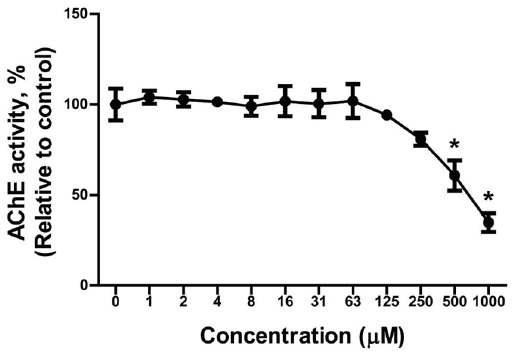Abstract
Studies using Alzheimer’s disease (AD) animal models simulating human AD pathology are essential for developing effective new drugs for patients with AD. Therefore, we aimed to analyze the effect of AF64A on the cholinergic and amyloidogenic pathways in human neural stem cells (hNSCs) and animals. The effects of AF64A were tested on acetylcholine esterase (AChE) activity, inflammatory response, and cholinergic and amyloidogenic pathways in hNSCs and brain tissues. Memory tests were performed four weeks after the AF64A injection. No significant differences were observed between low concentrations of AF64A (<250 μM) and the vehicle in the AChE activity test. Treatment of hNSCs (50 μM) and animals (5 μM) with AF64A revealed significant differences in the mRNA expression of nuclear factor kappa B, tumor necrosis factor-α, interleukin-6, inducible nitric oxide synthase, and cyclooxygenase-2 compared with that in controls. Additionally, the protein expression of choline acetyltransferase and vesicular acetylcholine transporter was significantly increased. Notably, treatment with AF64A also affected the amyloidogenic pathway by increasing the expression of beta-secretase1 and decreasing the expression of insulin-degrading enzyme and neprilysin, leading to the increased expression of the amyloid beta protein. Moreover, rats treated with AF64A exhibited significant differences compared with the control group in the memory test. Therefore, the AF64A-induced AD model can be used in acetylcholine-related research as well as in amyloid beta-related research, and could facilitate studies evaluating the therapeutic effect of drugs, as memory deficits are maintained in this model for over four weeks.
Figures & Tables

Fig. 1. Acetylcholinesterase (AChE) activity using brain tissue. For this assay, 100 μL AF64A (0–1,000 μM) was added to the assay mixture (1.0 mL PBS) containing 33 μL of 1.5 mM acetylcholine iodide, 33 μL of 1.5 mM 5.5′-dithiobis-(2-nitrobenzoic acid), and 50 μL brain homogenate. Data are expressed as the mean ± SD. All samples were analyzed in triplicate. *indicates significantly different from vehicle (<0. 0.05).


